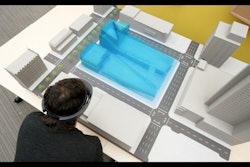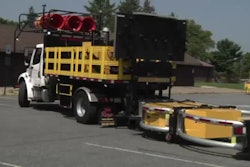
Technological innovations are seeping into the industry so thoroughly that even the humble hard hat is changing, with high-tech smart hats coming to the market, alongside new advances that benefit every area of the industry. Tech is making construction safer and more efficient. Here are six areas where technology is revolutionizing the construction industry.
1. The office: keeping paperwork in order
Contractor licensing and OHSA requirements are likely to get more complicated as technology changes. Fortunately, new tools are arriving to make this easier for you.
New apps help you keep data in order and share information between the office and job sites — an app like Safety Meeting helps you keep track of your business's safety record.
Surety agencies are beginning to offer electronic bonding; this is vital for you as contractor license bonds continue to be an important part of your business (here's a comprehensive surety bond definition if you need a refresher). This process is becoming quick and hassle-free.
2. Autonomous trucks: driverless solutions
From bulldozers to freightliners, trucking is becoming smart. Rio Tinto mining in Australia is currently utilizing 69 autonomous dump trucks with GPS to transport ore. The trucks are controlled remotely by a single driver, which amounts to a more efficient use of resources and creates a safer work environment for employees. These trucks get loads to their destination with fewer delays and less fuel usage than trucks with human drivers.
Mining isn’t the only place driverless trucks are showing up. Autonomous crash attenuator trucks are coming to the highway construction zones of Florida — the first state to test this type of vehicle. Crash attenuator trucks save lives in construction zones but endanger their drivers, so this pilot program uses completely driverless trucks. The technology works by leader/follower programming or remote control, utilizing GPS Waypoint navigation.
Safer Work Zones a Reality with Driverless Vehicle Technology
3. Materials: revolutionary or recycled
Carbon fiber and 3D printing are changing the way items like turbine blades are constructed. The carbon fiber is printed in honeycomb-shaped structures, with reinforced cell walls making it durable. This technology has the ability to revolutionize the creation of wind turbine blades and other instruments currently created from balsa wood. The balsa tree is fast-growing, but its wood is expensive and natural fluctuations in grain patterns make it difficult to create precision instruments.
Not all construction materials need to be new: sometimes they can be recycled instead. Concrete is a common construction material, but over time it breaks down. While the idea of recycling concrete and the process aren’t new, what is new is the approach. Recycling concrete is generally very difficult and potentially dangerous to do because it produces questionable quality, strength and durability.
Up-and-coming technology and research will mean that the concrete industry’s impact, mainly in the form of obtaining aggregate, will be able to be reduced through recycling. It may not be in common practice just yet, but you should look out for this on the horizon.
4. At the jobsite: monitoring productivity
Drones are popping up everywhere, and the jobsite is no different. Look out for drones checking on job progress and keeping the site secure. Drones are mapping worksites and generally keeping tabs on productivity and safety. Footage shot by drones is even being used to analyze when jobs will be finished and show progress to clients. In essence, drones are becoming productivity monitors.
How Drones Can Fly Construction Zones Profitably and Legally
[QUOTABLE]How Drone Photography is Changing Construction Profitability
Live construction drawings are creating a real-time progress monitor that can be viewed anywhere. Fieldlens is just one program that allows you to view your plans from anywhere, including on a mobile device. It allows users to communicate about drawings right on top of them, as well as what’s really happening on site. Other features include project imaging and weather reports, making for better communication and less time spent on reports.
5. On the road: street smarts
While some technologies are already being piloted, others are still in the works. For instance, smarter roads are being developed. Dutch firm Heijmans and designer Daan Rosegaarde are working on a technology called Smart Highway that incorporates glow-in-the-dark lining on road decks, electric priority lanes, interactive lighting and utilization of dynamic paint.
Another Dutch company, SolaRoad, is working on roads that will generate solar power. These roads will absorb sunlight and convert it to electricity. So far, it has been tested outside of Amsterdam and generated about 3,000 kWh in the first six months.
Is Solar the Road to the Future?
These road innovations will change the way we think about roads, and the way they’re constructed.
6. Equipment: wearing your tech
Hard hats have always been a symbol of construction workers. Smart Helmet takes a mandatory piece of equipment and makes it an amazing piece of wearable tech. It’s equipped with a transparent visor, special lenses and 4D augmented reality to give the wearer a heads-up.
Using sensors and cameras, it gives a variety of information about the surrounding environment and how to move through it. The helmet gives instructions on completing tasks and warns of potential hazards. These new additions put a twist on an old mainstay, making it a useful piece of personal equipment for years into the future.
Now that you’re feeling enthusiastic about the future of construction, keep in mind that some things will never change. Follow this contractor license bond guide to keep your business running smoothly, and new technology will make other parts of your construction business more productive and efficient.
Which new technologies are you excited about? Let us know in the comments below.
Eric Halsey is a historian by training and disposition who’s been interested in U.S. small businesses since working at the House Committee on Small Business in 2006. Coming from a family with a history of working on industry policy, he has a particular interest in the surety bonding industry with a focus on construction contracting and loves sharing his knowledge for JW Surety Bonds.




![[Video] Leica Geosystems and Milrem AS Team Up for World's First All-terrain Mobile Mapping UGV](https://img.forconstructionpros.com/files/base/acbm/fcp/image/2016/07/default.5788eb2ea4bad.png?auto=format%2Ccompress&fit=crop&h=167&q=70&w=250)















